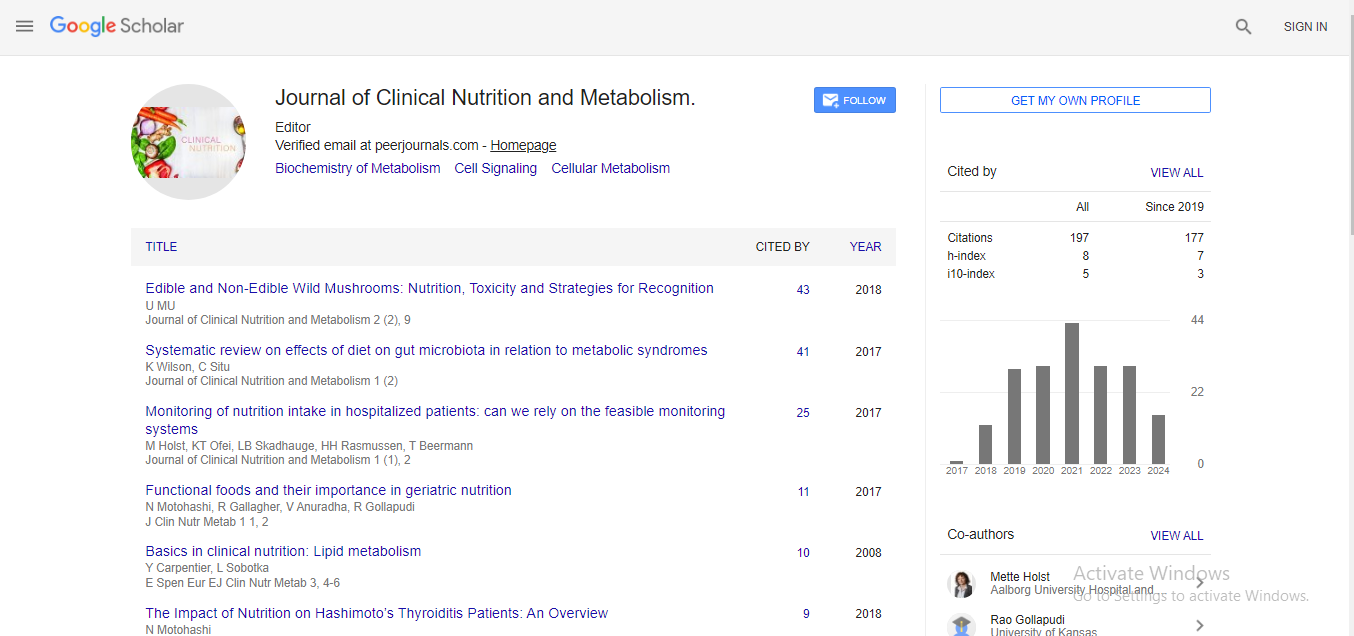Short Communication, J Clin Nutr Metab Vol: 4 Issue: 3
Clinical Nutrition 2017: Biomedical activities of anthocyanin extract derived from the Solanum tuberosum L. Vitelotte - Paola Bontempo - University of Campania Luigi Vanvitelli
Paola Bontempo University of Campania Luigi Vanvitelli, Italy
Keywords: Biomedical, anthocyanin
Epidemiological examinations propose that people expending an eating regimen wealthy in foods grown from the ground have a diminished danger of creating non-transmittable ailments, for example, malignancy. Solanum tuberosum L. var. Vitelotte is a potato assortment with dark blue skin and violet tissue broadly utilized for human utilization and all around refreshing for its great dietary qualities. The shades answerable for its appealing shading have a place with the class of anthocyanins. The motivation behind this investigation was to examine the biomedical exercises of anthocyanins remove got from the Solanum tuberosum. The primary destinations were to describe and gauge the convergence of anthocyanins in pigmented potatoes, and to assess their cell reinforcement, antimicrobial exercises and their enemy of proliferative impacts in strong and hematological malignant growth cell lines. Atomic genotyping was performed to appropriately distinguish this remarkable genotype in contrast with other potato assortments and to advance the usage of this hereditary asset by plant raisers. Anthocyanins apply hostile to bacterial action against various bacterial strains and a slight action against three contagious strains. The Gram-positive bacterium Staphylococcus aureus and the organism Rhyzoctonia solani were the most influenced microorganisms. Cell reinforcement exercises were assessed by DPPH and FRAP techniques; the concentrate indicated a higher decreasing ability than against radical movement. In various malignant growth cell models, the anthocyanins cause restraint of multiplication and apoptosis in a portion subordinate way. Moreover, cell and sub-atomic portrayal of the activity of anthocyanin remove in disease cells uncovered that tweak of cell cycle controllers happens upon treatment. Just as instigating apoptotic players, for example, TRAIL in disease frameworks, anthocyanin extricate repressed Akt-mTOR flagging, subsequently prompting development of intense myeloid leukemia cells. These carbon-based movements are likely because of the high substance of malvidin 3-O-p-coumaroyl-rutinoside-5-O-glucoside and petunidin 3-O-p-coumaroyl-rutinoside-5-Oglucoside. These outcomes are of enthusiasm for perspective on the effect on food utilization and as Useful food parts on potential malignant growth treatment and avoidance. For both basic arrangement rehashes (SSR) investigation and organic measures, plant materials (leaves and tubers, individually) of Vitelotte were gathered at Nusco (Avellino) in Southern Italy. Tubers were washed in running faucet water, cut into cuts of 0.5 mm in width, dried in a warmed air dryer, and afterward pummeled by the disintegrator. Subsequent to drying, the heaviness of potatoes was 157 g. Tests were kept at 4 °C. DNA for SSR profiling correlations was separated from the leaves of 12 extra assortments: Agata, Agria, Asterix, Badia, Bartina, Inova, Marabel, Primura, Sieglinde, Spunta, Vivaldi, and Volumia. Plants were developed under nursery conditions at the Department of Agricultural Sciences, University of Naples Federico II. Methanol was bought from Carlo Erba. Oil Red O and Hematoxylin arrangement, Harris altered were bought from Sigma Aldrich, Isopropanol was bought from Merck-Millipore, and Everolimus was bought from BioVision. For the game plan and depiction of the harsh concentrate (CE) see Gellatly et al. (Gellatly, Moorhead, Duff, Lefebvre, and Plaxton, 1994) and for anthocyanin remove (AE) see Bontempo et al. additionally, references in that (Bontempo et al., 2013). Immediately, pigmented potato powder was set into a 50 mL conelike cup, by then included destructive ethanol (HCl, 1.5 mol/L) with a solid liquid extent 1:32 (w/v) and put in thermostatic water shower at a picked temperature (80 °C) for 60 min, by then, centrifuged at 3220 g for 15 min. The supernatant was assembled and moved into a 50 mL volumetric flask for the affirmation of anthocyanin yield. Around 1 g of the models was used for each treatment. Potato genomic DNA was separated in duplicate from a pool of totally made young leaves from three special plants of each genotype using the show as of late reported (De Masi et al., 2007). DNA genuineness and quality were checked by gel electrophoresis and spectrophotometric assessment. Sub-nuclear examinations of SSR loci were finished by using eight nuclear microsatellite basis sets. This work is partly presented at 14th International Conference on Clinical Nutrition July 27-29, 2017 held at Rome, Italy For cell cycle investigation and assessment of pre-G1 stage, tests were prepared as recently detailed. Quickly, tests were resuspended in PBS-1× containing PI (50 g/mL), sodium citrate (0.1%) and NP40 (0.1%), and afterw ard broke down utilizing the FACScalibur stream cytometer with ModFit innovation (Becton Dickinson). Apoptosis was estimated as pre-G1 DNA discontinuity as recently revealed.
 Spanish
Spanish  Chinese
Chinese  Russian
Russian  German
German  French
French  Japanese
Japanese  Portuguese
Portuguese  Hindi
Hindi 